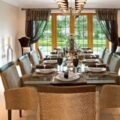You’re probably familiar with timers for LED Christmas lights. You adjust the timing unit to make your lights flash or follow a sequence. You can also vary the speed at which the lights go on and off. And although you may not want the same effects for your home LED lighting, you can still use timers to save money, ensure security and create outdoor displays.
Garden Lights
Timers for LED garden lighting systems switch your bulbs on and off at given times. Some people also employ a timer to alter the hue of colour-changing bulbs.
General Outdoor Lighting
LED bulbs are replacing public lighting systems around the world. You can do something similar at home. If you have security lights by your front or back doors, replace them with LED light bulbs. Timers can switch the lights on at night and turn them off in the morning.
Night Lights
An LED night light has an automatic timer built into it. Simply plug the unit into a socket. The light comes on when the room darkens, and goes off at dawn. A night light particularly suits a hallway or children’s bedroom.
Aquarium Lights
Owners of home aquariums are increasingly turning to LED lights. The bulbs are cheaper to run than standard equivalents and last longer. And you can use a timer to control and dim the lights as appropriate.
12-Volt Timers
If you have a 12-volt LED lighting circuit, you can add a programmable timer. When you’re away, you can programme your lights to go on and off at set times. This gives the impression someone’s at home.
Don’t forget: if you are making changes to your wiring or need help and advice about fitting LED timing systems, consult a suitably qualified electrical contractor. This will guarantee your safety and the success of your LED project.
Date: October 3, 2011
Tags: LED Lighting Seasonal
Create stunning displays with LED lighting timers. Find out how to use them for garden, outdoor, night and aquarium lights.




